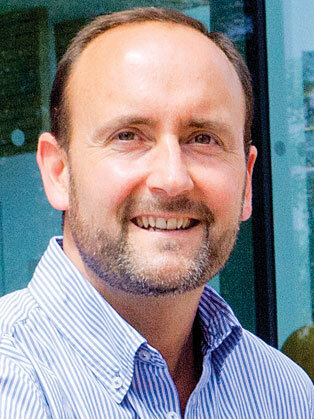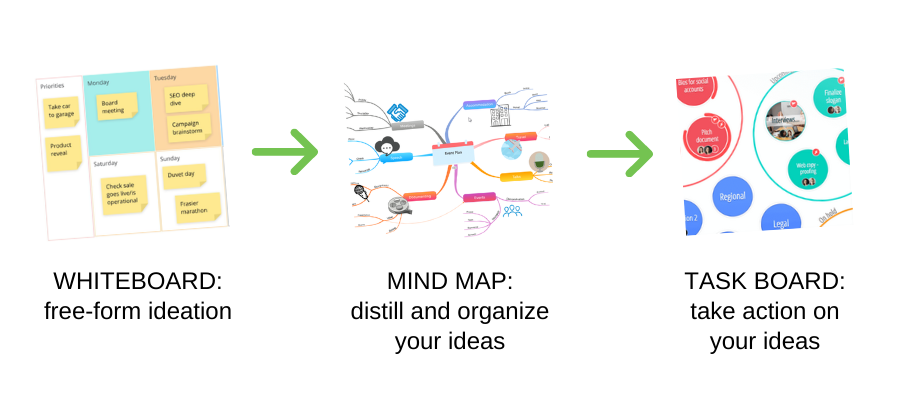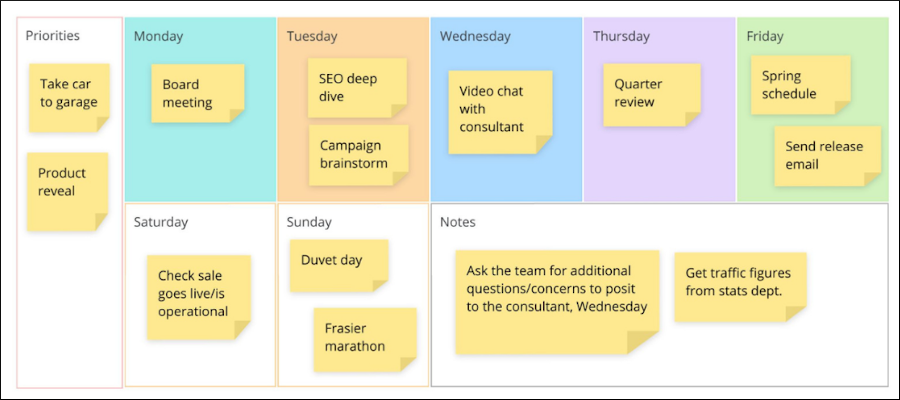
OpenGenius recently announced that it has added a whiteboard to its Ayoa mind mapping and task management tool. I wasn’t quite clear how this new feature fit in with the rest, or how it reflects the changing needs of its customers. So I interviewed CEO Chris Griffiths to gain some insights into Ayoa’s current direction and to learn what’s next for it.
What I discovered is a development team that’s committed to helping individuals and teams brainstorm flexibly (using the whiteboard), distill their ideas into plans (using Ayoa’s mind mapping tool) and take action on them (using its task management tool set).
Chuck Frey: From your company’s perspective, how are business’ needs for collaboration changing and evolving?
 Chris Griffiths: A key point here is the understanding that collaboration does not equal productivity. The pandemic has created a situation where teams are now often over-collaborating and therefore not necessarily being more productive.
Chris Griffiths: A key point here is the understanding that collaboration does not equal productivity. The pandemic has created a situation where teams are now often over-collaborating and therefore not necessarily being more productive.
Creativity also relies on collaboration – but without adequate tools and processes teams can unknowingly be negatively impacting their ability to innovate. This is such a shame, because now more than at any time I can remember, we have a perfect environment to be creative.
Let’s face it, when do you do your most creative thinking? In a business suit whilst in a conference room, or in your pajamas, lounging in a comfortable chair with your feet up? Working from home allows time to think, or more importantly, to daydream. The problem is that people need to capture and shape these thoughts with their teams, and need appropriate tools to do this. This is why we built Ayoa.
Frey: Has the current environment increased the need for individuals and teams to be more innovative? If so, why?
Griffiths: Definitely. The working world as we know it is changing rapidly – just think of how quickly many of us have had to adapt to working remotely, for example! Without innovative technologies, this transition would have been far less seamless.
We need innovation to help us overcome unique challenges and find new and better ways of doing things – which is exactly what we’ll be continuing to deal with for some time yet.
Frey: The Ayoa website says your mission is “to educate, motivate and facilitate practical innovation into your everyday – so you can dare to achieve more.” How is Ayoa bringing that mission into reality?
Griffiths: Ayoa was created out of a need to promote practical innovation using technology. The range of features Ayoa offers gives you the freedom to learn to be innovative – even if you don’t necessarily think you are a creative thinker.
Our new whiteboard is a blank canvas that can be used in any way you want, but we also offer a range of templates to encourage users to challenge their thinking and approach problems from different perspectives.
Most importantly, Ayoa allows you to not only generate ideas, but turn them into action – only once your ideas are actioned can you truly “achieve more.”
Frey: I get the sense from your website that flexibility and fluidity of thinking and working with ideas is pretty important. Why is that?
Griffiths: At Ayoa, we understand that everyone works differently and what works for one person, won’t work for another. Despite many people thinking that they’re simply not “the creative type,” everyone has the power to generate innovative ideas that make a difference. We believe that they just need the right tools to help them foster their creativity.
Teams are diverse. So team members being able to view the same information in a way that suits them is really important. And of course, with 2020 being probably the most unpredictable year to date, flexibility is key!
Frey: How has Ayoa evolved since it was formally launched a year and a half ago?
Griffiths: When Ayoa first launched, it combined aspects of two existing apps; iMindMap and Droptask. As a result, the main features it offered were mind mapping, task management and instant messaging. Over the past year and a half, it has become so much more than that.
While it still offers the same mind mapping and task management capabilities that were loved by iMindMap and DropTask users, the introduction of whiteboards and a range of other exciting new features have meant that Ayoa is now an all-in-one digital workspace that can be used to collaborate on projects, keep track of what the rest of your team are working on at any time, and plan and host video meetings.
Many people will not remember this, but we developed our first virtual whiteboard tool HiCortex back in 2014, so we could bring what we learned into Ayoa.
The aim is that an Ayoa user can start with free-form visual thinking with our whiteboards, build on those ideas using mind maps, and then turn ideas into action using our task boards. Missing any of those stages creates weakness in objective thinking and productivity.

Frey: How have the global pandemic and the rise of remote work changed Ayoa’s path?
Griffiths: Remote working was already gaining traction before the pandemic, so it was always the plan to incorporate more features to help people stay connected and collaborate on work from different locations. However, it definitely caused us to change the releases we prioritized working on this year.
The sudden increase in remote working saw a huge demand for tools that can help teams stay on the same page, no matter when or where they’re working – and we wanted to be able to fulfill this need as quickly as possible.
As a result, we launched a Zoom integration, integrated video meetings, user groups, user statuses, team pulse dashboard, live share, and of course, our new collaborative whiteboards.
Frey: Did your product roadmap always include a commitment to expand it beyond mind mapping to other forms of visual thinking?
Griffiths: Yes. Mind mapping will always be a big part of Ayoa, but everyone works differently. Some people love the visual nature of a mind map; others would prefer to put their ideas into the format of a simple list. Each has advantages and disadvantages.
We pride ourselves on being a versatile tool, and the freedom of whiteboards enables us to offer even more flexibility. Ultimately, what is most important is that you allow a person the freedom to work the way their brain wants to work. Forcing them to do otherwise is counter-productive.
Mind mapping is often thought to be great for creativity because it is so flexible, whereas in fact, mind mapping is a very structured form of thinking. This is why it is so powerful in growing ideas.
However, that structure does not allow for the free flowing non-structured thinking that is possible using whiteboards. The combination of these is therefore very powerful.
A key strength in Ayoa is to do the ‘capture’ stage using whiteboards, and doing the initial sorting and filtering using our ‘section’ elements, which can then be exported to a mind map where selected groups of ideas can be developed within the mind map structure.

Frey: What was behind your decision to add a whiteboard to Ayoa?
Griffiths: This was a natural progression for us. We launched HiCortex back in 2014 to test virtual collaboration through whiteboards. We believed by combining what we learnt from iMindMap, Droptask and HiCortex into one single platform we can help systematize creativity using technology.
Also, think of any office; what one thing do they have in common? They have a physical whiteboard for everyone to jot down ideas and make a note of anything they want to share with their team. In fact, it’s one of the main ways teams communicate with each other! It is a great starting point for ideation.
With many of us now working remotely (and continuing to do so for the foreseeable future), we wanted to help teams stay connected by giving them the freedom to take their office whiteboard with them anywhere.
Frey: I was surprised to see that even free users of Ayoa get access to whiteboards. It sounds like you view this to be a key part of the visual toolkit for today’s workers.
Griffiths: Definitely. Whiteboards are such a key part of any office, so why should that be any different for a virtual one? As a clean whiteboard is a completely blank canvas, it offers unlimited uses. This gives you the flexibility to be as creative as you need, giving you the power to devise innovative solutions to whatever challenge you’re tasked with.
Frey: What are the most popular uses of it?
Griffiths: The great thing about our new whiteboards feature is that it is extremely flexible. Like a physical whiteboard, it can be used in virtually any way you want. However, some of the most popular users for teams and individual users is to brainstorm ideas for projects and create detailed plans for meetings, campaigns, or anything else they happen to be working on.
The options truly are endless. This is why we’ve created an extensive template library so users can get started quickly – whether they want to create a to-do list, take meeting notes, or conduct an in-depth analysis of their ideas. Visit www.ayoa.com/templates to see over 50 different ways you can utilize whiteboards to help your thinking.
Frey: It’s not clear from your website – does the whiteboard support dot voting on ideas?
Griffiths: We actually offer a similar functionality to this, with users being able to vote on lists and sticky notes by giving them a quick “thumbs up.” The total number of votes will be displayed at the bottom of the element on the whiteboard, making it easy to see at a glance how many people like a particular idea.
Frey: What happens after your team is done brainstorming in the whiteboard? Is it possible to convert their ideas directly into a mind map?
Griffiths: Yes, they can. We don’t want our users’ ideas to sit on the board, waiting to be actioned – we want to give them the ability to take these further by turning them into an actionable plan.
For this reason, we’ve specifically designed our new whiteboards to be used in conjunction with our existing mind mapping and task management features, enabling users to put their ideas into the format that best suits their project and turn them into actionable tasks.
Frey: To convert ideas into a mind map, how do you do that? Do you need to manually drag and drop them into a mind map structure, or does Ayoa automate that in some way?
Griffiths: In Ayoa, we offer the option to easily turn your whiteboard into a task board or mind map. All you will need to do is select the option to export your whiteboard as a mind map or task board and choose whether you want to create a new board or add the contents of your whiteboard to an existing one.
Ayoa will do all the hard work for you by automatically transforming it into the format you need. Alternatively, you can export an individual section of your whiteboard into a task board or mind map. This is useful if you have a particular section you would like to explore in more detail. See our user guide here.
Frey: So why should people use Ayoa for whiteboarding instead of a dedicated collaborative whiteboard tool like Mural or Miro?
Griffiths: Ayoa is backed by over 15 years of experience and expertise in innovative technology, encased in a beautiful, positive and inspiring UI. Mural and Miro are good whiteboard tools, but Ayoa has something more for those who want to shake things up and go the extra mile. Why use multiple different tools when you can access everything in one place?
Flexibility and teamwork are more important now than ever. Ayoa’s flexibility and all-in-one collaborative workspace is unrivaled. Ayoa is unique in this aspect in that it has whiteboarding, powerful mind mapping, and task management all in one place.
Frey: I see from your road map that more functionality is coming soon for the whiteboards? (mobile whiteboarding and presenting whiteboards)
Griffiths: Yes, we have big plans in store for whiteboards – it doesn’t stop here. We want our users to be able to access their work at any time and from anywhere, as well as make it as easy as possible for them to share their plans and ideas with others. Watch this space!
Frey: What’s next for Ayoa?
Griffiths: 2020 was a big year for Ayoa, seeing the launch of a number of exciting new features that we’re extremely proud of! With that in mind, in 2021, we want to focus on fine-tuning our features and making continuous improvements to the app, so we can provide our users with the best possible experience.
Ayoa is still a very young app, and we will strive to deliver technology that doesn’t get in the way of the thinking process. We also will aim to integrate more process-based methodologies with Ayoa. We will start by including many of the systems and processes from my latest book, The Creative Thinking Handbook, which I am proud to say has been licensed in over 10 countries during the last 12 months.

Leave a Reply